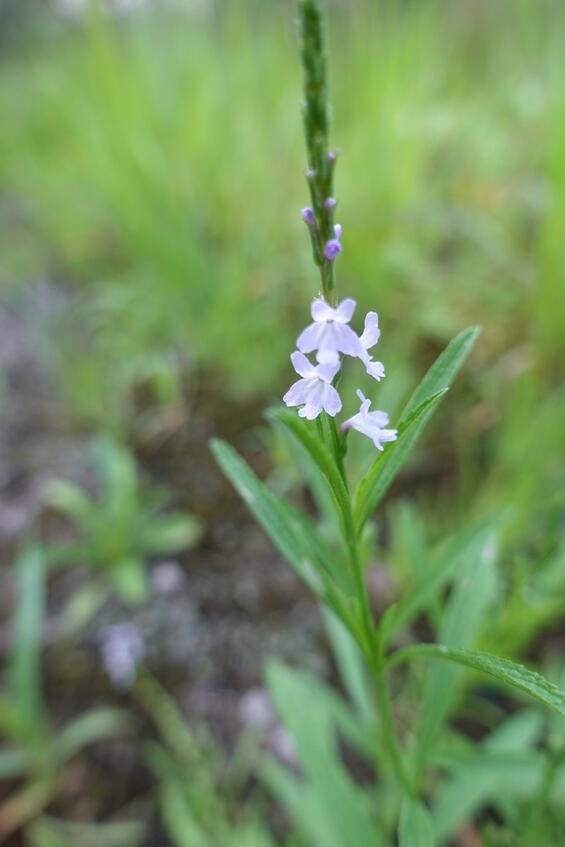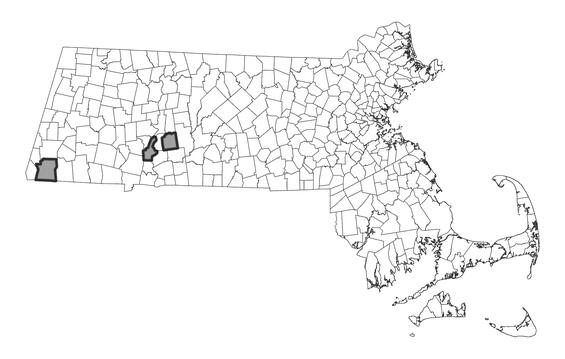- Scientific name: Verbena simplex
- Species of Greatest Conservation Need (MA State Wildlife Action Plan)
- Endangered (MA Endangered Species Act)
Description

Narrow-leaved vervain (Verbena simplex) is a perennial herb of circumneutral to basic outcrops or ledges. A member of the vervain family (Verbenaceae), it has opposite leaves and lavender flowers that bloom from May to September.
Narrow-leaved vervain is up to 60 cm (2 feet) tall, with an erect, finely hairy stem that is simple or branched sparingly toward the top. The leaves are opposite, 3-10 cm (1.2-4 inches) long, with forward-facing (serrate) teeth. They are narrowly lanceolate in shape and taper toward nearly stalkless (sessile) bases. The lavender flowers, which grow on slender spikes, are very small (up to 8 mm; 0.3 inch), and tube-shaped, with five lobes flaring out at the summit. Narrow-leaved vervain produces fruit from early July to mid-September.
Blue vervain (Verbena hastata) resembles the narrow-leaved vervain but is a plant of moist meadows and swales and is unlikely to be found in the dry, rocky habitat of the narrow-leaved Vervain. Its leaves are short-stalked and longer than those of narrow-leaved vervain, starting at 10 cm (4 in). Only the largest leaves of narrow-leaved vervain reach this length. The inflorescence of blue vervain is composed of many branches of spikes, compared to the simpler inflorescence of the narrow-leaved vervain, with spikes either solitary or merely in threes.
Life cycle and behavior
This is a perennial species.

Population status
Narrow-leaved vervain is listed under the Massachusetts Endangered Species Act as Endangered. All listed species are legally protected from killing, collection, possession, or sale and from activities that would destroy habitat and thus directly or indirectly cause mortality or disrupt critical behaviors. MassWildlife’s Natural Heritage & Endangered Species Program database has 7 records from 4 counties: Berkshire, Hampden, Hampshire, and Worcester. Three of those records are within the last 25-year period.

Distribution in Massachusetts. 1999-2024. Based on records in the Natural Heritage Database.
Distribution and abundance
The range of narrow-leaved vervain extends from southwestern Quebec and Ontario and most of New England west to Minnesota, and south to Texas and Florida. Narrow-leaved vervain is also known to be rare in Minnesota, Nebraska, New Jersey, North Carolina, Wisconsin, and Quebec, and its status is under review in several other states. It is historically known from Vermont and Delaware.
Habitat
Narrow-leaved vervain inhabits open areas, in full sun, on rocky circumneutral or calcareous soils. Known habitats include the upper walls of an abandoned marble quarry and a steeply pitched traprock clearing on the southeastern slope of a mountain. Associated plant species include eastern red cedar (Juniperus virginiana), American pennyroyal (Hedeoma pulegioides), poverty-grass (Danthonia spicata), and little bluestem (Schizachyrium scoparium). Rare Massachusetts plants that have been associated with narrow-leaved vervain include glaucescent sedge (Carex glaucodea, endangered), green rock-cress (Boechera missouriensis, threatened), and yellow oak (Quercus muehlenbergii, threatened).
Healthy habitats are vital for supporting native wildlife and plants. Explore habitats and learn about conservation and restoration in Massachusetts.
Threats
Narrow-leaved vervain can be over-shaded when sites succeed to closed-canopy forest. A decline in natural fire, forest cutting, and grazing has decreased the amount of open habitat. Also, invasive exotic plants may over-shade or out-compete narrow-leaved vervain at some sites.
Conservation
As with many rare species, the exact management needs of narrow-leaved vervain are not known. Sites should be monitored for over-shading caused by forest succession, for exotic plant invasions, and for trampling due to foot traffic. Habitat sites that do not receive enough light can be managed with canopy thinning or prescribed burning. If trampling or erosion are threats in recreational areas, trails can be re-routed or stabilized. To avoid inadvertent harm to rare plants, all active management of rare plant populations (including invasive species removal) should be planned in consultation with MassWildlife’s Natural Heritage & Endangered Species Program.
Contact
| Date published: | May 7, 2025 |
|---|